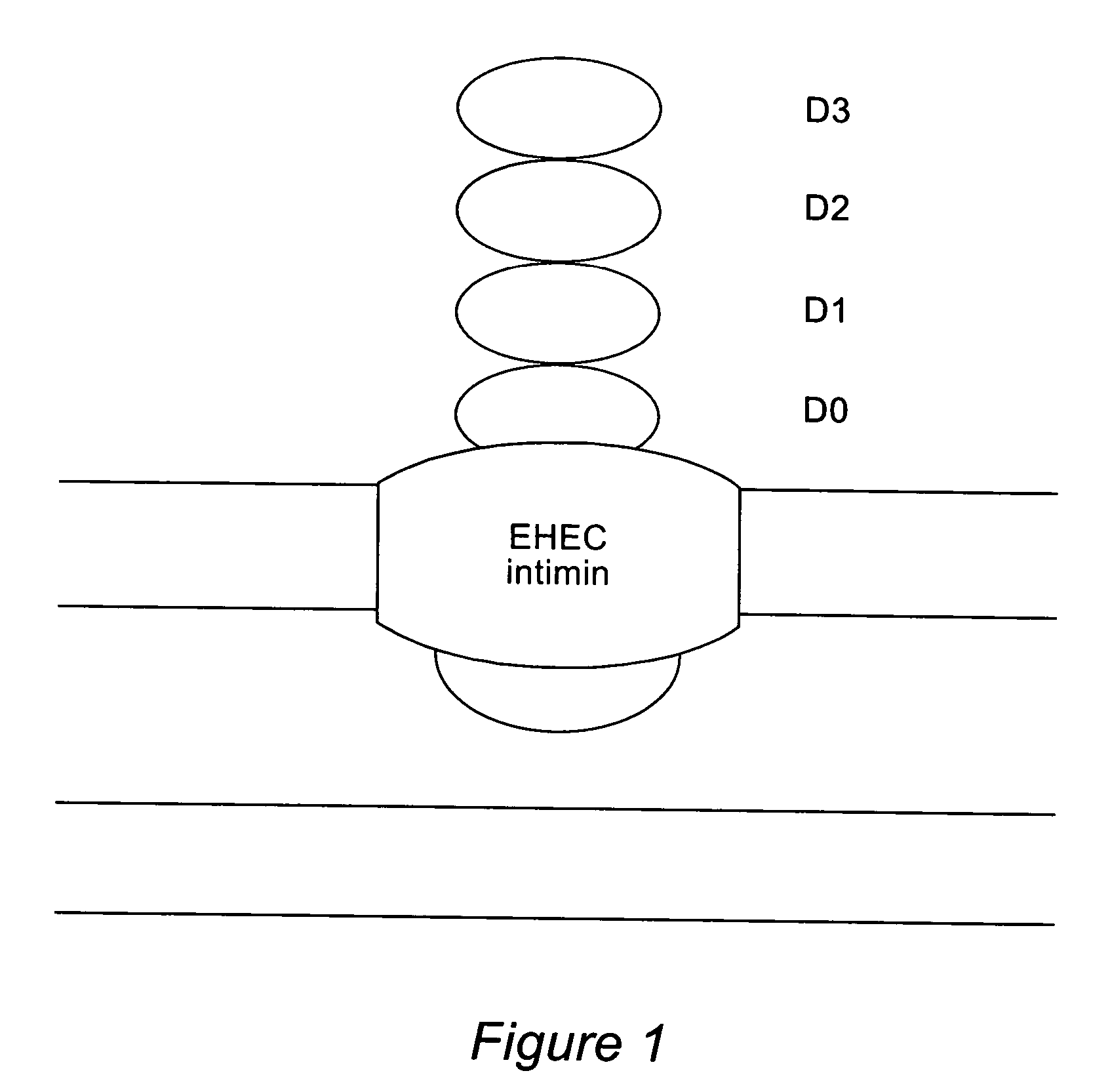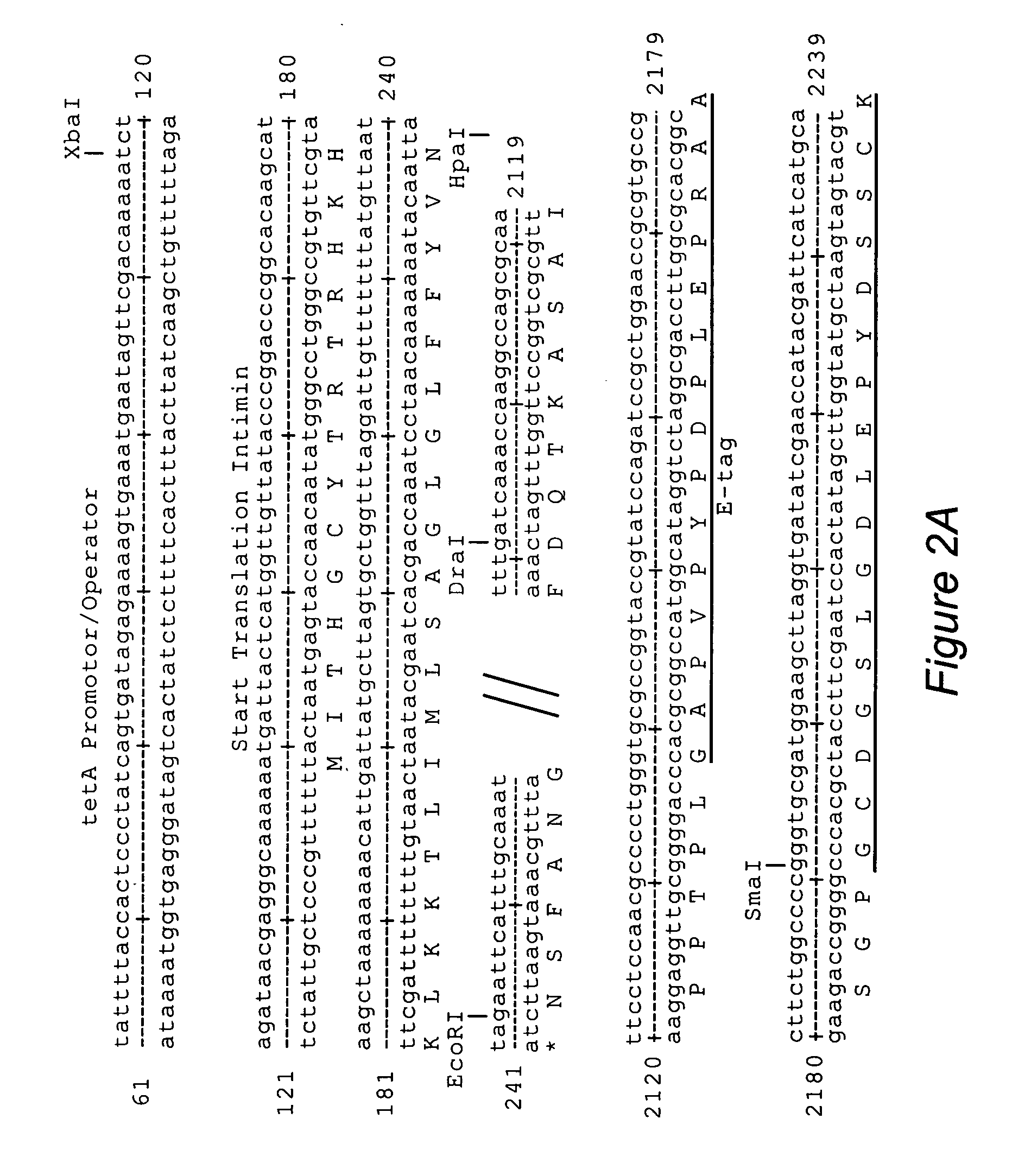Method for exposing peptides and polypeptides on the cell surface of bacteria
a technology of peptides and polypeptides, applied in the field of exposing peptides and polypeptides on the cell surface of bacteria, can solve the problems of difficult introduction of corresponding gene variants, large number of gram-positive bacteria, and low suitability for large peptide libraries
- Summary
- Abstract
- Description
- Claims
- Application Information
AI Technical Summary
Benefits of technology
Problems solved by technology
Method used
Image
Examples
example 1
Gene Fusion of a Nucleic Acid Sequence Segment Coding for a Passenger Protein and One Coding for an Intimin Fragment Vector Construction, and comparative Example
[0084]The cystine node polypeptide EETI-II, a trypsin protease inhibitor comprising 28 amino acids, was selected as the passenger for the first example (as previously used by: Wentzel et al. (1999), J. Biol. Chem. 274: 21037–21043; Christmann et al. (1999), Protein Eng. 12: 797–806).
[0085]For that purpose, the Intimin gene eae (Gene Bank Accession Z11541) from EHEC O157:H7 Strain 933 bacteria was amplified with the polymerase chain reaction using the oligonucleotides Intiminup (SEQ ID NO:9) and Intiminlo (SEQ ID NO:8). EHEC O157:H7 bacteria inactivated by boiling were used as the template. The gene was amplified with the following amplification conditions: 30 sec 94° C., 30 sec 53° C. and 2 min 72° C., 30 cycles.
[0086]The oligonucleotide Intiminup hybridizes the eae gene from nucleotide 69 to 88. This sequence segment contai...
example 2
Bacterial Surface Exposure of Protein Fragments, Epitope Mapping, and Isolation of Monospecific Antibodies
[0101]The gene for PMS1 from the yeast S. cerevisiae (Gene Bank Accession Number M29688) was used as the model antigen. The gene (2.7 kB) was amplified using the PCR primers PMS1up (SEQ ID NO: 12) and PMS1lo (SEQ ID NO: 13) from S. cerevisiae. The DNA was purified with the Nucleotrap PCR kit (Machery and Nagel). The DNAse I digestion was carried out in four different trial solutions using 1.8* 10−2, 2,7?., 10−2, 3.6* 10−2 and 0.18 υ DNAse I [tr. note #9] in the presence of 2 mM MnCl2.5 μg DNA was used per solution. The restriction cutting was stopped by addition of 500 mM EDTA after 10 minutes at room temperature. The resulting fragments were separated on a 12.5% polyacrylamide gel after staining with ethidium bromide. Fragments in the size range of 40–100 bp were cut out. Then the fragments were eluted from the gel by diffusion overnight in TBE buffer. Then any DNAse I that mig...
example 3
Isolation of Peptides with Affinity to a Specified Target Protein by Intimin-based Surface Exposure of Combinatorial Peptide Libraries
[0105]A library of variants of the cystine node protein EETI-II, comprising 28 amino acids, was generated. EETI-II is a trypsin protease inhibitor that occurs in the vegetable marrow Ecballium elaterium. This peptide is stabilized by three intramolecular disulfide bridges which produce a series of surface loops (described in Wentzel et al. (1999), J. Biol. Chem. 274: 21037–21043). A library of EETI-II variants was generated, in which the groups of two loop regions exposed to the solvent are randomized. The amino acid sequence of the EETI-II collection is: GCXXXXMRCKQDSDCLAGCVCQVLXPXXSXCG (SEQ ID NO:7). (Amino acids in one-letter code. The two loop regions in which amino acid position(x)s are randomized are indicated in italics.)
[0106]The randomized eeti genes were generated using PCR. An eeti-ckSend gene (see above) was used as the template. It was am...
PUM
| Property | Measurement | Unit |
|---|---|---|
| pH | aaaaa | aaaaa |
| pH | aaaaa | aaaaa |
| binding affinity | aaaaa | aaaaa |
Abstract
Description
Claims
Application Information
 Login to View More
Login to View More - R&D
- Intellectual Property
- Life Sciences
- Materials
- Tech Scout
- Unparalleled Data Quality
- Higher Quality Content
- 60% Fewer Hallucinations
Browse by: Latest US Patents, China's latest patents, Technical Efficacy Thesaurus, Application Domain, Technology Topic, Popular Technical Reports.
© 2025 PatSnap. All rights reserved.Legal|Privacy policy|Modern Slavery Act Transparency Statement|Sitemap|About US| Contact US: help@patsnap.com



